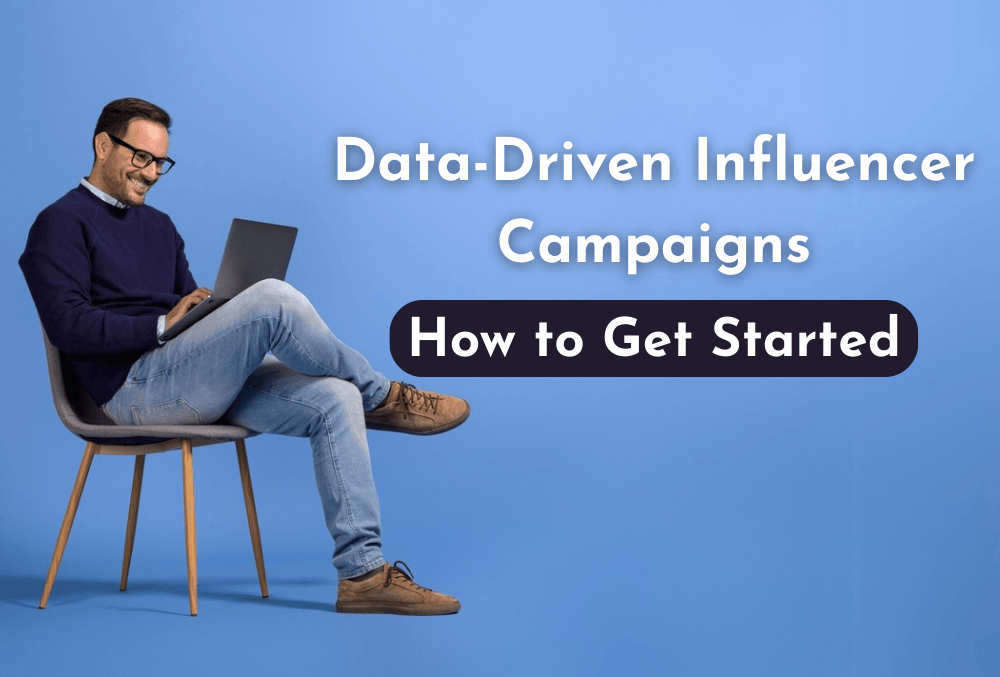“In today’s world, influencer marketing isn’t about wild guesses — it’s about wise decisions. Data is no longer optional; it’s your campaign’s secret weapon.”
For brands, influencer marketing has evolved from a creative trend to a strategic performance channel. Yet, many are still navigating this space with intuition alone — hoping the right reel or post catches fire.
But hope isn’t a strategy. Data is.
In this blog, we’ll help you understand what data-driven influencer campaigns are, why they matter more than ever, and how your brand can confidently take the first steps toward executing a campaign that’s not only creative — but calculable.
📌 What Is a Data-Driven Influencer Campaign?
A data-driven influencer campaign uses real-time insights and analytics at every stage — from creator selection to post-campaign analysis — to make decisions that enhance performance and ROI.
Rather than relying on how a creator’s feed “feels,” brands now dig into how their content performs: engagement quality, audience demographics, click-through rates, and conversions.
In short, it’s shifting from guessing to growing — with numbers doing the talking.
💼 Why Should Brands Go Data-First in Influencer Marketing?
Because it makes your marketing spend work harder and smarter.
Here’s what data unlocks for you:
- 🎯 Targeted Creator Selection: Go beyond follower count — pick influencers whose audience aligns with your customer profile.
- 📉 Avoid Wastage: Identify creators with fake engagement or bots before investing.
- 📊 Track & Optimize Performance: Know what’s working mid-campaign — and pivot fast.
- 💡 Learn & Scale: Build a campaign blueprint you can replicate based on hard numbers.
🔢 Key Metrics That Matter
Let’s break down the must-track metrics in a data-driven campaign:
| Metric | Why It’s Important |
| Engagement Rate | Measures how actively an influencer’s audience interacts with content. |
| Audience Demographics | Ensures the influencer’s followers align with your brand’s target. |
| Reach & Impressions | Shows how far your content traveled. |
| Click-Through Rate (CTR) | Indicates how compelling your offer or CTA is. |
| Conversion Rate | The ultimate goal — did people take action? |
| Sentiment Analysis | Understand how audiences feel about your brand. |
| Cost Per Engagement (CPE) | Helps measure cost-efficiency of your spend. |
🚀 How to Start a Data-Driven Influencer Campaign
Here’s a step-by-step breakdown to guide your brand:
1. Set Clear, Measurable Goals
Define what success looks like. Awareness? Website traffic? Product sales?
Example: “We want to drive 2,000 link clicks from Instagram Reels with a CTR of 3%.”
2. Choose Influencers Based on Data, Not Just Aesthetics
SocioCreator,not only gives you the proper aesthetics profile but the data drive insights of each creator you want to work with.
- Engagement trends
- Audience authenticity
- Geo-reach
- Past performance on similar campaigns
Bonus Tip: Ask for a media kit with insights before onboarding.
3. Collaborate on Content, but Let Insights Guide Format
Use past performance to decide on the right format — Stories, Reels, static posts, or carousels.
If your past campaign saw high saves on tutorials, replicate that. If clicks peaked during swipe-up Reels, lean in.
4. Track in Real-Time & Be Ready to Pivot
Set up UTM tracking, custom discount codes, or affiliate links to monitor each influencer’s impact.
Use dashboards or analytics tools to track mid-campaign performance and adjust your budget or messaging accordingly.
5. Post-Campaign: Analyze, Learn, Scale
Once the campaign ends:
- Identify high-performing influencers
- Study content styles that clicked
- Measure against KPIs
- Build a benchmark for future campaigns
🧠 Real-Life Example: How Data Drove Results
A homegrown coffee brand ran two influencer campaigns:
- Campaign A: Influencers picked based on visual vibe.
- Campaign B: Creators selected through data — aligned demographics, engagement history, CTR benchmarks.
Results:
Campaign A brought high likes but low sales.
Campaign B saw 2.5x return on investment with 30% lower cost per acquisition.
Lesson: Data doesn’t kill creativity — it sharpens it.
⚠️ Don’t Fall into These Common Traps
- ❌ Prioritizing aesthetics over audience match
- ❌ Ignoring metrics like CTR or demographics
- ❌ Not defining KPIs at campaign start
- ❌ Tracking engagement only, without conversion analysis
- ❌ Failing to repurpose or boost top-performing content
🤖 How Data & AI Work Together in Influencer Campaigns
Modern platforms now use AI to recommend creators, optimize budget allocation, and predict content success based on historical patterns. Don’t just track data — let it lead the way.
“SocioCreator upcoming update will also have the AI update, to make the platform more easy and suitable for all your influencers needs Stay tuned.”
❓ FAQs
Q1. What’s the difference between traditional and data-driven influencer campaigns?
Traditional campaigns focus on content aesthetics; data-driven ones focus on performance, alignment, and results.
Q2. Can small businesses benefit from data-driven campaigns?
Yes — even with modest budgets, data helps pick the right creators, optimize spend, and ensure results.
Q3. How do I track performance if influencers don’t share backend data?
Use UTM links, custom codes, or influencer platforms that integrate tracking.
Q4. Is data more important than creativity?
It’s not either/or — the magic happens when creative content is guided by smart data.
🧩 Bonus: Combine Influencer Content with Paid Boosting
Your top-performing influencer posts? Boost them using paid ads to:
- Expand reach beyond organic followers
- Retarget warm audiences
- Drive conversions with better credibility
This hybrid approach gives you the trust of influencers + the scale of paid media.
🏁 Final Thoughts: Data Is the New Direction
Influencer marketing is no longer just about storytelling. It’s about smart storytelling — guided by data, optimized in real-time, and measured for impact.
Whether you’re launching your first creator campaign or scaling your efforts, remember: when insights lead, impact follows.

